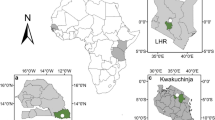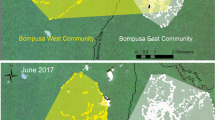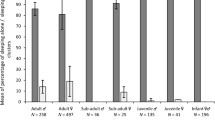Abstract
The assessment of how primates divide their daily activities is one of the foundations of primate behavioral ecology but the activity patterns and social behavior of the Pitheciines, including bearded sakis (genus Chiropotes), are poorly understood. During a 15-mo study, I collected 560 h of data on subgrouping, activity patterns, social behavior, and intergroup encounters of a group of free-ranging Guianan bearded sakis (Chiropotes sagulatus) in Guyana. The study group consisted of at least 65 individuals but showed a high degree of flexibility in grouping patterns (mean group size 39 ± 10). They were highly active, spending ca. 70% of their diurnal activity budget traveling and feeding. Activity patterns were relatively consistent throughout the year, although time spent feeding correlated significantly with fruit availability. The most common social behaviors were social resting and grooming. Agonism was rare (2.56% of social behavior) but did occur in the context of intergroup encounters, with males from the same group cooperating in intergroup agonism. Bearded sakis showed a high level of within group male affiliation, with male–male partners making up 65% of grooming dyads and males having another male as their nearest-neighbor 66% of the time. These results show that bearded sakis are characterized by egalitarian male–male and male–female relationships, highly fluid group sizes, and high levels of male affiliation. Similarities in the social behavior of bearded sakis and muriquis suggest several possible explanations for male–male bonding including cooperative defense of females from other groups, kinship, and maintenance of social cohesion after subgroup coalescence.





Similar content being viewed by others
References
Altmann, J. (1974). Observational study of behavior: sampling methods. Behavior, 49, 227–267.
Aureli, F., & Schaffner, C. M. (2007). Aggression and conflict management at fusion in spider monkeys. Biology Letters, 3, 147–149.
Aureli, F., Schaffner, C. M., Boesch, C., Bearder, S. K., Call, J., Chapman, C. A., et al. (2008). Fission-fusion dynamics: new research frameworks. Current Anthropology, 49, 627–654.
Ayres, J. M. (1986). The white uakaris and the Amazonian flooded forests. Doctoral dissertation, Cambridge University.
Ayres, J. M. (1989). Comparative feeding ecology of the uakari and bearded saki, Cacajao and Chiropotes. Journal of Human Evolution, 18, 697-716.
Barnett, A. A., Volkmar de Castilho, C., Shapley, R. L., & Anicacio, A. (2005). Diet, habitat selection and natural history of Cacajao melanocephalus ouakary in Jau National Park, Brazil. International Journal of Primatology, 26, 949–970.
Boubli, J. P. (1999). Feeding ecology of black-headed uacaris (Cacajao melanocephalus melanocephalus) in Pico de Neblina National Park, Brazil. International Journal of Primatology, 20, 719–749.
Bowler, M., & Bodmer, R. (2009). Social behavior in fission-fusion groups of red uakari monkeys (Cacajao calvus ucayalii). American Journal of Primatology, 71, 976–987.
Bowler, M., & Bodmer, R. (2011). Diet and food choice in Peruvian red uakaris (Cacajao calvus ucayalii) selective or opportunistic seed predation? International Journal of Primatology, 32, 1109–1122.
Bowler, M., Knogge, C., Heymann, E. W., & Zinner, D. (2012). Multilevel societies in New World primates? Flexibility may characterize the organization of Peruvian red uakaris (Cacajao calvus ucayalii). International Journal of Primatology, 33, 1110–1124.
Boyle, S. A. (2008). The effects of forest fragmentation on primates in the Brazilian Amazon. Ph.D. dissertation, Arizona State University, Tempe.
Boyle, S. A., & Smith, A. T. (2010). Behavioral modifications in northern bearded saki monkeys (Chiropotes satanas chiropotes) in forest fragments of central Amazonia. Primates, 51, 43–51.
Boyle, S. A., Lourenço, W. C., da Silva, L. R., & Smith, A. T. (2009). Travel and spatial patterns change when Chiropotes satanas chiropotes inhabit forest fragments. International Journal of Primatology, 30, 515–531.
Chapman, C. A., & Chapman, L. J. (2000). Determinants of group size in social primates: The importance of travel costs. In S. Boinski & P. Garber (Eds.), On the move: How and why animals travel in groups (pp. 24–42). Chicago: University of Chicago Press.
Clutton-Brock, T. H., & Harvey, P. H. (1977). Species differences in feeding and ranging behaviour in primates. In T. H. Clutton-Brock (Ed.), Primate ecology: Studies of feeding and ranging behaviour in lemurs, monkeys and apes (pp. 557–584). London: Academic Press.
Defler, T. R. (1995). The time budget of a group of wild woolly monkeys (Lagothrix lagotricha). International Journal of Primatology, 16, 107–120.
Defler, T. R. (1999). Fission-fusion in the black-headed uacari (Cacajao melanocephalus) in eastern Colombia. Neotropical Primates, 7, 5–8.
Di Fiore, A. (2012). Genetic consequences of primate social organization. In J. C. Mitani, J. Call, P. M. Kappeler, R. A. Palombit, & J. B. Silk (Eds.), The evolution of primate societies. Chicago: University of Chicago Press.
Di Fiore, A., & Rodman, P. S. (2001). Time allocation patterns of lowland woolly monkeys (Lagothrix lagotricha poeppigii) in a Neotropical terra firma forest. International Journal of Primatology, 22, 449–480.
Di Fiore, A., Link, A., & Campbell, C. J. (2011). The atelines: Behavioral and socioecological diversity in a new world monkey radiation. In C. J. Campbell, A. Fuentes, K. C. MacKinnon, M. Panger, & S. K. Bearder (Eds.), Primates in perspective (2nd ed., pp. 155–188). New York: Oxford University Press.
Garber, P. A., & Kowalewski, M. (2011). Collective action and male affiliation in howler monkeys (Alouatta caraya). In R. W. Sussman & C. R. Cloninger (Eds.), Origins of altruism and cooperation (pp. 145–165). Developments in Primatology: Progress and Prospects. New York: Springer Science+Business Media.
Garber, P. A., & Kowelewski, M. (2013). Male cooperation in Pitheciines: The reproductive costs and benefits to individuals of forming large multimale-multifemale groups. In A. A. Barnett, L. M. Veiga, S. F. Ferrari, & M. A. Norconk (Eds.), Evolutionary biology and conservation of titis, sakis and uacaris. Cambridge: Cambridge University Press.
Gregory, T. L. (2011). Socioecology of the Guianan bearded saki, Chiropotes sagulatus. Ph.D. dissertation, Kent State University, Kent.
Hemingway, C. A., & Bynum, N. (2005). The influence of seasonality on primate diet and ranging. In D. K. Brockman & C. P. van Schaik (Eds.), Seasonality in primates (pp. 57–104). Cambridge: Cambridge University Press.
Hinde, R. A. (1983). Primate social relationships: An integrated approach. Oxford: Blackwell.
Janson, C. H. (2000). Primate socio-ecology: the end of a golden age. Evolutionary Anthropology, 9, 73–86.
Junk, W. J. (1993). Wetlands of the world: Inventory, ecology, and management, vol. 1: Wetlands of tropical South America (pp. 679–739). Dordrecht: Kluwer Academic.
Kappeler, P. M., & van Schaik, C. P. (2002). Evolution of primate social systems. International Journal of Primatology, 23, 707–740.
Kinzey, W. G., & Norconk, M. A. (1990). Hardness as a basis of fruit choice in two sympatric primates. American Journal of Physical Anthropology, 81(1), 5–15.
Kinzey, W. G. (1992). Dietary and dental adaptations in the Pitheciinae. American Journal of Physical Anthropology, 88, 499–514.
Koenig, A. (2002). Competition for resources and its behavioral consequences among female primates. International Journal of Primatology, 23, 759–783.
Koenig, A., Beise, J., Chalise, M. K., & Ganzhorn, J. U. (1998). When females should contest for food – testing hypotheses about resource density, distribution, size, and quality with Hanuman langurs (Presbytis entellus). Behavioral Ecology and Sociobiology, 42, 225–237.
Lehmann, J., Korstjens, A. H., & Dunbar, R. I. M. (2007). Group size, grooming and social cohesion in primates. Animal Behaviour, 74, 1617–1629.
Lewis, R. J., & Kappeler, P. M. (2005). Seasonality, body condition, and timing of reproduction in Propithecus verreauxi verreauxi in the Kirindy Forest. American Journal of Primatology, 67, 347–364.
Mangel, M., & Clark, C. W. (1986). Towards a unified foraging theory. Ecology, 67, 1127–1138.
Milton, K. (1980). The foraging strategy of howler monkeys: A study in primate economics. New York: Columbia University Press.
Mittermeier, R. A., & van Roosmalen, M. G. M. (1981). Preliminary observations on habitat utilization and diet in eight Surinam monkeys. Folia Primatologica, 36, 1–39.
Nishida, T., Kano, T., Goodall, J., McGrew, W. C., & Nakamura, M. (1999). Ethogram and ethnography of Mahale chimpanzees. Anthropological Science, 107, 141–188.
Norconk, M. A. (2011). Saki, uakaris, and titi monkeys: Behavioral diversity in a radiation of primate seed predators. In C. J. Campbell, A. Fuentes, K. C. MacKinnon, M. Panger, & S. K. Bearder (Eds.), Primates in perspective (2nd ed., pp. 123–138). New York: Oxford University Press.
Norconk, M. A., & Kinzey, W. G. (1994). Challenge of neotropical frugivory: travel patterns of spider monkeys and bearded sakis. American Journal of Primatology, 34, 171–183.
Nunn, C. L. (2000). Collective benefits, free-riders, and male extra-group conflict. In P. M. Kappeler (Ed.), Primate males: Causes and consequence of variation in group composition (pp. 192–204). Cambridge: Cambridge University Press.
Peetz, A. (2001). Ecology and social organization of the bearded saki (Chiropotes satanas chiropotes). Ecotropical monographs no. 1. Bremen: Society of Tropical Ecology.
Pereira, M. E. (1993). Seasonal adjustment of growth rate and adult body weight in ringtailed lemurs. In P. M. Kappeler & J. H. Ganzhorn (Eds.), Lemur social systems and their ecological basis (pp. 205–221). New York: Plenum Press.
Peres, C. A. (1994). Diet and feeding ecology of gray woolly monkeys (Lagothrix lagotricha Cana) in Central Amazonia: comparisons with other atelines. International Journal of Primatology, 15, 333–372.
Peres, C. A. (1996). Use of space, spatial group structure, and foraging group size of gray woolly monkeys (Lagothrix lagotricha cana) at Urucu, Brazil. In M. A. Norconk, A. L. Rosenberger, & P. A. Garber (Eds.), Adaptive radiations of Neotropical primates (pp. 467–488). New York: Plenum Press.
Pinto, L. P. (2008). Ecologia alimentar do cuxiú-de-nariz-vermelho Chiropotes albinasus (Primates: Pitheciidae) na Floresta Nacional do Tapajós, Pará. Doctoral dissertation, Universidade Estadual de Campinas, Campinas (Brazil).
Pinto, L. P., Barnett, A. A., Bezerra, B. M., et al. (2013). Why we know so little: The challenges of fieldwork on the Pitheciids. In L. M. Veiga, A. A. Barnett, S. F. Ferrari, & M. A. Norconk (Eds.), Evolutionary biology and conservation of titis, sakis and uacaris (pp. 145–150). Cambridge: Cambridge University Press.
Robinson, J. G. (1986). Seasonal variation in use of time and space by the wedge-capped capuchin monkey, Cebus olivaceus: implications from foraging theory. Smithsonian Contribution to Zoology, 431, 1–60.
Santos, R. R. (2002). Ecologia de cuxiús (Chiropotes satanas) na Amazonia Oriental: perspectivas para a conservação de populações fragmentadas. Master’s thesis, Museu Paraense Emílio Goeldi and Universidade Federal do Pará, Belém (Brazil).
Schneider, H., & Rosenberger, A. L. (1996). Molecules, morphology and platyrrhine systematics. In M. A. Norconk, A. L. Rosenberger & P. A. Garber (Eds.), Adaptive Radiations of Neotropical Primates. New York: Plenum Press.
Schoener, T. W. (1971). Theory of feeding strategies. Annual Review of Ecology and Systematics, 2, 369–403.
Shaffer, C. A. (2012). Ranging behavior, group cohesiveness, and patch use in northern bearded sakis (Chiropotes sagulatus) in Guyana. Ph.D. dissertation, Washington University in St. Louis, St. Louis.
Shaffer, C. A. (2013a). GIS analysis of patch use and group cohesiveness of bearded sakis (Chiropotes sagulatus) in the Upper Essequibo Conservation Concession, Guyana. American Journal of Physical Anthropology, 150, 235–246.
Shaffer, C. A. (2013b). Feeding ecology of northern bearded sakis (Chiropotes sagulatus) in Guyana. American Journal of Primatology, 75, 568–580.
Silva Júnior, J. S., & Figueiredo, W. M. B. (2002). Pithecíneos: Uma última fronteira amazônica, Revisão sistemática dos cuxiús, género Chiropotes Lesson, 1840 (Primates, Pithecidae), p. 21. Brazil.
Silva, S. S. B., & Ferrari, S. F. (2009). Behavior patterns of southern bearded sakis (Chiropotes satanas) in the fragmented landscape of eastern Brazilian Amazonia. American Journal of Primatology, 71, 1–7.
Sterck, E. A., Watts, D. P., & van Schaik, C. P. (1997). The evolution of female social relationships in primates. Behavioral Ecology and Sociobiology, 41, 291–310.
Stevenson, P. R., Quinones, M. J., & Ahumeda, J. A. (1994). Ecological strategies of woolly monkeys (Lagothrix lagotricha) at Tinigua National Park, Colombia. American Journal of Primatology, 32, 123–140.
Strier, K. B. (1986). The behavior and ecology of the woolly spider monkey, or muriqui (Brachyteles arachnoides E. Geoffroy 1806). Ph.D. dissertation, Harvard University.
Strier, K. B. (1992). Atelinae adaptations: behavioral strategies and ecological constraints. American Journal of Physical Anthropology, 88, 515–524.
Strier, K. B. (1994). Brotherhoods among atelines. Behaviour, 130, 151–167.
Strier, K. B., Dib, L. T., & Figueira, J. E. C. (2002). Social dynamics of male muriquis (Brachyteles arachnoides hypoxanthus). Behaviour, 139, 315–342.
Struhsaker, T. T. (1975). The Red Colobus Monkey. Chicago: University of Chicago Press.
Sussman, R. W., Garber, P. A., & Cheverud, J. M. (2005). Importance of cooperation and affiliation in the evolution of primate sociality. American Journal of Physical Anthropology, 128, 84–97.
Symington, M. M. (1990). Fission–fusion social organization in Ateles and Pan. International Journal of Primatology, 11, 47–61.
Terborgh, J. (1983). Five New World Primates: A study in comparative ecology. Princeton: Princeton University Press.
Thompson, C. L., & Norconk, M. A. (2011). Within-group social bonds in white-faced saki monkeys (Pithecia pithecia) display male-female pair preference. American Journal of Primatology, 73, 1051–1061.
van Doorn, A., O’Riain, M. J., & Swedell, L. (2009). The effects of seasonality and day length on the activity budget and diet of semi-commensal chacma baboons (Papio ursinus) in the Cape Peninsula of South Africa. American Journal of Primatology, 72, 104–112.
van Hooff, J. A. R. A. M., & van Schaik, C. P. (1994). Male bonds: affiliative relationships among nonhuman primate males. Behaviour, 130, 309–337.
van Schaik, C. P. (1983). Why are diurnal primates living in groups? Behavior, 87, 120–122.
van Schaik, C. P. (1996). Social evolution in primates: the role of ecological factors and male behaviour. Proceedings of the British Academy, 88, 9–31.
van Schaik, C. P., & Kappeler, P. M. (2006). Cooperation in primates and humans: Closing the gap. In P. M. Kappeler & C. P. van Schaik (Eds.), Cooperation in primates and humans (pp. 3–21). Heidelberg: Springer Science+Business Media.
van Schaik, C. P., & van Noordwijk, M. A. (1985). Interannual variability in fruit abundance and the reproductive seasonality in Sumatran long-tailed macaques (Macaca fascicularis). Journal of Zoological Society of London, 206, 533–549.
Veiga, L. (2006). Ecologia e comportamento do cuxiú-preto (Chiropotes satanas) na paisagem fragmentada da Amazônia oriental. Doctoral dissertation, Universidade Federal do Pará, Belém.
Veiga, L. M., & Silva, S. S. B. (2005). Relatives or just good friends? Affiliative relationships among male bearded sakis (Chiropotes satanas) in Tucurui, Brazil. Livro de Resumos, XI Congresso Brasileiro de Primatologia, Porto Alegre, February 13–18, 2005, p. 174.
Wittmann, F., Schongart, J., Montero, J. C., Motzer, T., Junk, W. J., Piedade, M. T. F., et al. (2006). Tree species composition and diversity gradients in white-water forests across the Amazon Basin. Journal of Biogeography, 33, 1334–1347.
Wrangham, R. W. (1980). An ecological model of female-bonded primate groups. Behavior, 75, 262–300.
Acknowledgments
I thank the Environmental Protection Agency of Guyana and Conservation International – Guyana for granting permission for me to conduct this research. I am grateful for the logistic support provided by CI – Guyana, in particular Eustace Alexander. I particularly thank my local field assistants, especially Defraites Bowen, Henry James, and Hendricks Simon. I also thank Robert Sussman, Marilyn Norconk, Joanna Setchell, and two anonymous reviewers for their helpful comments on this manuscript. This research was approved by the Environmental Protection Agency of Guyana and the Institutional Animal Care and Use Committee of Washington University. Financial support was provided by the National Science Foundation (#0648678), Lambda Alpha, and Conservation International – Guyana.
Author information
Authors and Affiliations
Corresponding author
Rights and permissions
About this article
Cite this article
Shaffer, C.A. Activity Patterns, Intergroup Encounters, and Male Affiliation in Free-Ranging Bearded Sakis (Chiropotes sagulatus). Int J Primatol 34, 1190–1208 (2013). https://doi.org/10.1007/s10764-013-9727-3
Received:
Accepted:
Published:
Issue Date:
DOI: https://doi.org/10.1007/s10764-013-9727-3




